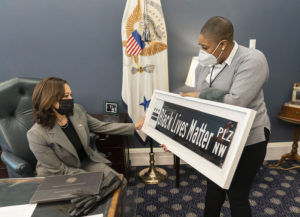
Chief Spokes Person for the Vice President Symone Sanders shows Vice President Kamala Harris a Black Lives Matter street sign Tuesday, Feb. 16, 2021, in her West Wing Office of the White House. The sign is a gift from DC Mayor Muriel Bowser. (Official White House Photo by Lawrence Jackson)
Black Lives Matter’s antipolice agenda is “out of step with the thinking of most blacks today and most blacks for at least the past half-century,” informs readers of Jason Riley in the WSJ. Another way of putting it is “coming undone” Several years ago, Dick and I had the pleasure of lunching with Jason at a Cato/Naples event before Jason spoke to the Cato audience.
As Jason explains in The Journal, in 2013 after the acquittal of George Zimmerman, BLM’s reputation gained ground. One year later, when Michael Brown was killed in Ferguson, Mo., BLM’s reputation increasingly flourished.
According to a national poll published by the Daily Kos, support for BLM peaked at 52% in June 2020, a month after George Floyd was murdered by a police officer in Minneapolis.
(BLM’s) popularity has declined since then, and recent revelations about the organization’s spending habits are unlikely to reverse that trend.
Why BLM’s Reversal?
After the New York Post reported in April 2021 that a BLM co-founder had purchased four homes for a total of $3.2 million, the head of a local BLM chapter in New York City called for an independent investigation into how money was being spent.
In July, BLM leaders in Canada, with help from its U.S. affiliate, purchased another multi-million dollar mansion in Toronto, which prompted several activists in the local chapter to resign.
And earlier this month, New York magazine reported that BLM leaders purchased a $6 million California home in cash with money that had been donated to the organization.
From the NY Post: “The transaction has not been previously reported, and Black Lives Matter leadership had hoped to keep the house’s existence a secret. …
Internal emails dating to 2016 show activists voicing concern about how donations were being spent and how the organization was being run.
The families of some Black victims of police violence have complained that they have seen little of the funds that have flowed to the movements most visible facet.
George Floyd’s death helped provide a windfall for the group, continues Mr. Riley.
In October 2020, it took in $66.5 million in contributions. Weeks later, it purchased the California property. BLM told the magazine that it had “always planned” to disclose the purchase, but didn’t explain why it hadn’t.
Questions also surfaced about how money not going into pricey real-estate is being managed. Earlier this year one news outlet reported that attorneys general in California and Washington state had ordered BLM to cease fundraising activities until the group submitted delinquent financial disclosures. According to the organization (BLM), “We take these matters seriously and have taken immediate action.”
As Mr. Riley explains, “If the public doesn’t know more about these shenanigans, New York magazine explained that it might be because the organization carefully monitors social media for negative mentions.”
Members use their influence with the platforms to have such remarks removed.” BLM also hired private investigators “to look into [BLM] detractors and journalists.”
The Myth BLM Perpetrated
BLM has another problem: “its prominence has been propelled in part by lies and half-truths,” according to Mr. Riley.
Michael Brown was shot dead after he attacked a police officer, and the “Hands up, don’t shoot!” story is a myth. Trayvon Martin was a troubled young man, and based on physical evidence the jury determined that Mr. Zimmerman fired at him in self-defense.
There is nothing wrong with calling out dirty cops or police brutality, which aren’t figments of black people’s imaginations. But neither do most blacks believe, as BLM types insist, that policing is a larger problem than criminal behavior. Like Garvey and the Black Panthers, BLM represents a fringe minority of black Americans rather than the mainstream majority.
A Pew Research Center survey released last week found that crime is the top concern of black adults, which is nothing new. The 1968 Kerner Commission report noted that the loudest complaints from black neighborhoods concerned the lack of police protection—specifically, the relatively small number of cops assigned to black neighborhoods and their slow response to emergency calls.




